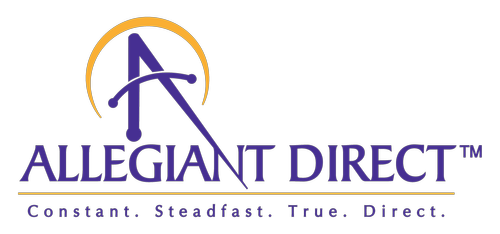The Allegiant Direct Blogs

More dollars...more donors...with “OPTIMIZED GIFT ASK”
By Wayne Gurley
President & Creative Director
For a few years now, we've been using something called "OPTIMIZED GIFT ASK" to increase the amount of money donors contribute to a direct mail solicitation.
Simply put, “OPTIMIZED GIFT ASK” combines predictive analysis with proven fundraising tactics to build an appropriate, personalized ask strategy for each donor. Amounts are calculated to upgrade donors and improve retention.
Results have been extraordinary in generating more donors and dollars for our clients.
"OPTIMIZED GIFT ASK" results...
A recent test of "OGA" produced a stunning outcome...
A small number of donors (1,231) were split with segment A receiving OGA and segment B receiving a standard gift upgrade starting with the donors' most recent gift. Here's what happened...
OPTIMIZED GIFT ASK: 25.81% response with $14,086 income.
REGULAR GIFT ASK: 5.93% response with $4,325 income.
The difference in response was a whopping 335%. Total difference in income was $9,761 - or a 225.6% improvement!
This increase was achieved due to a MORE APPROPRIATE ASK - neither too high nor too low, but a perfectly targeted amount the donor could achieve.
Although this particular test had the effect of significantly increasing response and income, it did not necessarily affect average gift.
The difference in average gift was $62.88 (with OGA) vs. $59.25 (without OGA), a slight increase of 6%. However, the use of OGA improved cost per dollar raised with the OGA group coming in at $0.08, as compared to $0.19 with the NON-OGA group. This was a 60% improvement.
(The lower number is better than the higher number since it's a reflection of the cost to raise one dollar.)
Interested in generating more donors and dollars?
If you're interested in learning more about how "OPTIMIZED GIFT ASK" can improve your direct mail income, email Shannon Russell: [email protected]
Or send questions to: [email protected]
© 2021 Allegiant Direct, Inc.
Frequently asked questions
What kind of copy gets the best response for healthcare fundraising?
Mainly, copy that’s relevant, focused on the donor and non-institutional. Our experience is that it needs to be something related to heart or cancer and perhaps technology that does something better, keeps you out of the hospital and/or is less costly and less invasive. For children’s hospitals and hospices, patient stories usually work best, but appeals for new technology, equipment or programs can also work well.
Which is best - a window or closed face envelope?
We use both depending on the situation. A closed face envelope is a little more expensive. However, the #10 window envelope has been a workhorse for us for many decades. For hospital grateful patients, we think it may work because it approximates the look of a hospital bill. You can split test window vs. closed face, and sometimes you’ll find that a window does better, and sometimes a closed face works better. A closed face envelope has a more professionally looking business correspondence feel to it.
What about using a teaser on the outside envelope?
We usually come down on the side of not using teasers. The reason - if you put something on the envelope that gives the recipient an idea of what's inside, and they're not interested – like if they can tell it's a fundraising letter - then the trash can is always nearby. The problem with teasers is that most people who write teasers do not know how to tease properly. A teaser has to have some mystery to it. So, when you see it, you say, “What's this all about?” Having no teaser is its own mystery because you're wondering “why are these people writing me?” Then you want to find out and you open the envelope. We’ve used teasers in the past and tested them. Sometimes they work, and sometimes they don't. More often than not, they don't work. So, unless you've got a superb teaser, you may want to not use one at all.
Which lists work best for healthcare fundraising?
Most of our hospital clients solicit former patients, and they mostly work well. But if you’re a hospice, you have few numbers of bereaved individuals to solicit. By the same token, if you’re a children’s hospital, you have a minimum number of patients to contact. Parents of children’s hospital patients (the guarantors) are too young to be good philanthropic prospects. As a result, what we've found is that rented lists of donors to healthcare causes in your area often work better than patients. With hospices and children’s homes, you almost have no choice but to use rented names to build your donor base. Perhaps surprisingly, rented names tend to outperform hospital grateful patients. But why would a person who hasn't been in your hospital perform better than someone who has? With patients, we really only know two things about them. We know they're the correct age because we can select them based on age or date of birth from the patient record. We also know they've been in the hospital. But that’s it. We don't know anything else about them. But with a rented name, we know they're the right age because they've given to other nonprofit organizations. They’re definitely philanthropic. They’ve also given through the mail and are responsive to mail appeals. We also know they like to give, and particularly to healthcare causes. So that gives them an edge on former patients.
Book A Call
(FREE 30 minute consult)
To make your FREE consult appointment, select a date and click submit,
then you will be taken to a page to select the time. We look forward to chatting
with you! (If our calendar is not available, please refresh your page.)
Contact Us for More Information
For general inquiries or to receive additional information about our services, please write or call us.
Allegiant Direct, Inc.
278 Franklin Road, Suite 290
Brentwood, TN 37027
Still have questions?

Allegiant Direct, Inc.
278 Franklin Road, Suite 290
Brentwood, TN 37027
Marketing Systems Built By Be Known
We make no income or earnings claims - your results may vary.
We present testimonials and insights about other people’s experiences with our website for purposes of illustration only. The testimonials and examples used are of actual clients. They are not intended to represent or guarantee that current or future clients will achieve the same or similar results; rather, these testimonials represent what is possible for illustrative purposes only.
This site is not a part of the Google or Facebook website or Google/Facebook/Meta Inc. Additionally, this site is NOT endorsed by or affiliated with Google or Facebook in any way. GOOGLE and FACEBOOK are trademarks of GOOGLE, Inc. and FACEBOOK, Inc or Meta, Inc.


